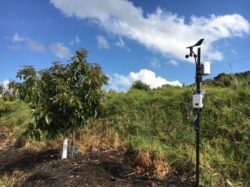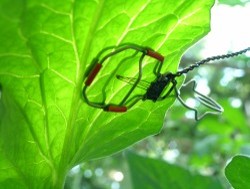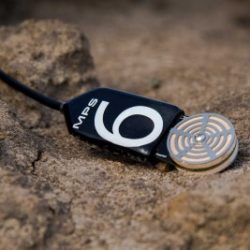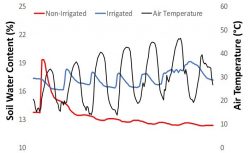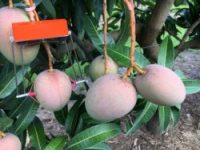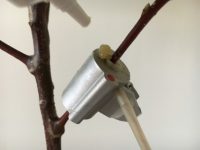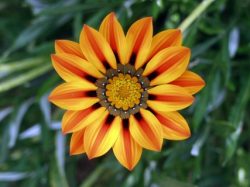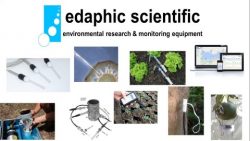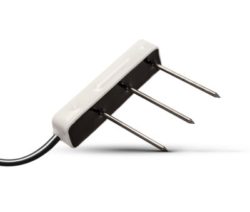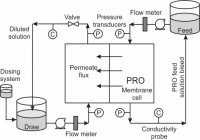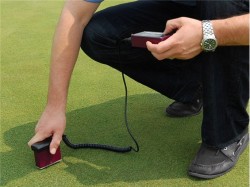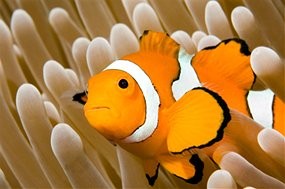Posts by Edaphic Scientific
New tensiometer-style sensor for avocado growers
A new, tensiometer-style sensor is improving irrigation management and saving time and costs for avocado growers. Irrigation monitoring and scheduling often relies on tensiometers – sensors that can measure soil water potential. Tensiometers are a favourite among avocado growers but they come with a huge problem: they are extremely tedious and odious to maintain. A…
Read MoreLeaf temperature sensors and water wise research
Plant physiologists and irrigation scientists need accurate and reliable leaf and canopy temperature sensors for scientific research. Recently, the LT-1T Leaf Temperature Sensor from Edaphic Scientific was deployed by researchers at the CSIRO for a project on irrigation management of tomato crops. The LT-1T is a small, temperature sensor that firmly clips onto a leaf.…
Read MoreWhy this sensor has made the tensiometer and gypsum block obsolete
New and improved technology is now available for growers that is enabling more efficient and lower cost irrigation. The technology is a significant improvement on older, tensiometer and gypsum block style sensors by requiring zero maintenance, having a higher accuracy and being more robust. The technology is called the TEROS 21 Soil Water Potential Sensor…
Read MoreGrapevines, sap flow and heatwaves
Heatwaves can have a significant impact on grapevines, scorching leaves and decreasing growth and yield. Grape growers deploy various strategies to protect their vines during extreme heat events which can include spraying canopies with “sunscreen”. Although these strategies have merit, they often involve investment in additional infrastructure or are laborious to employ. Another strategy involves…
Read MoreDetection of tree disease with sap flow sensors
Sap flow sensors can be used to study the hydraulic function of healthy versus diseased trees. Sap flow sensors can detect a decrease in hydraulic function associated with disease prior to the onset of outward, physical symptoms. Sap flow sensors, therefore, provide a tool for researchers to better understand the physiology of disease in trees.…
Read MoreGrowers workshop 2017
Edaphic Scientific participated in a series of workshops for macadamia and grape growers in November and December, 2017. The workshops covered topics such as heatwaves, irrigation and advanced technology to measure the water potential of crops. The workshops were organised by the Department of Primary Industries (DPI) New South Wales, and the Australian Macadamia Society.…
Read MoreDendrometers: multi-purpose sensors
Dendrometers are a multi-purpose sensor for measuring plant growth and water use. They are a precision sensor to measure small expansion and contractions in plant tissues over a daily cycle. They can also measure growth over several days, weeks and months. Therefore, dendrometers can be used for irrigation and fertigation management, as well as providing…
Read MoreMeasuring transpiration of small plants
Continuous measurements of the water use, or transpiration, of small or herbaceous plants can be difficult. A small weighing lysimeter, also known as a balance or scale, can be used however these often require a researcher to manually read the LCD screen or to have the instrument connected to a PC or laptop. Data collection…
Read MoreFlowers and transpiration
Surprisingly little research has been dedicated to flower water relations. This is despite the vast amount of research on water relations at the whole-plant level, stomatal conductance at the leaf level, and even the water relations of fruits. Flowers have been largely neglected probably due to the difficulty of accurately measuring transpiration rates with a…
Read MorePlant and Soil Workshops 2016
Edaphic Scientific has just held a series of one day workshops on water and nutrients in plants and soils. The workshops were held across Australia at the CSIRO, Macquarie University and The University of Queensland and were well attended by students, researchers and growers. The workshop consisted of a series of presentations followed by practical…
Read MoreMonitoring CO2 in Shopping Centres
You have probably never noticed a CO2 (carbon dioxide) detector when you’re at the shopping centre buying new clothes or shoes. More and more CO2 detectors are being installed in shopping centres to monitor CO2 for comfort and energy savings. Recently, the CO2meter.com Wall Mounted CO2 Detector with Alarm was installed for such reasons in…
Read MoreMarine Science Conference 2016
Edaphic Scientific attended the joint conference between the New Zealand Marine Sciences Society and Australian Marine Science Association in Wellington, New Zealand. The conference was attended by over 500 marine science researchers from Australia and New Zealand. Talks and posters covered a wide range of topics from ocean acidification to coral bleaching to marine parks…
Read MoreWhy your soil moisture measurements are not accurate
Manufacturers of soil water content sensors supply their product with an output registering volumetric water content (VWC), typically expressed as a percentage. But where does this number come from and what does it actually mean? In all likelihood, the output value from the sensor will not be equal to the actual VWC of your particular…
Read MoreScientists adrift in the Pacific on a Kon-Tiki tour
What would possess a team of scientists to drift on a primitive raft in the Pacific Ocean for over 60 days? As always, it is in the name of science – specifically anthropology and environmental science research. Known as the Kon-Tiki2 Expedition, the scientists are examining if it was possible for Polynesian and South American…
Read MoreRenewable energy from the mixing of wastewater streams
Dr Fernanda Helfer, Griffith University, was the recipient of the 2016 Edaphic Scientific Research Equipment Grant. In this blog post, Dr Helfer explains her research on renewable energy and wastewater. From 2013 to 2016, the global amount of fresh drinking water produced through seawater reverse osmosis desalination (RO) increased from 25 million m3day-1 to…
Read More5 common mistakes when measuring soil moisture
Soil moisture, or soil volumetric water content, is easily measured with probes, sensors or handheld meters. These meters are as simple as pushing the probe or sensor into the soil, pressing read on the handheld meter, and you’re done. As easy as this appears, there are surprisingly many pitfalls and traps that can lead to wrong…
Read MoreIs the Great Barrier Reef moving to Tasmania?
Many tropical marine species are starting to appear in temperate waters. Around Sydney, several tropical fishes, such as surgeonfish, have been observed. Corals have also been found to be overtaking algal forests off the coast of New South Wales. In New Zealand, tropical fishes have been observed in marine waters where they have never been seen…
Read Morewhat is biofilm?
Ever wondered what that slime is in your bathroom, or that plaque on your teeth? Most likely it is a biofilm – a community of bacteria growing within a slime on a surface that is constantly moist. Biofilms are everywhere – from that plaque on your teeth, to sewage pipes, to the guts of cows.…
Read Morehow plants communicate
can plants communicate with one another? This question is not as outrageous as it might at first seem. Certainly, plants are not like The Ents in the Lord of the Rings, coming to life and talking with one another. But scientists have amassed a large amount of evidence to suggest that plants do communicate with…
Read Morea blog on the latest in environmental research
Climate change, species extinctions, ecosystem processes, soils and plants… and how the science of light, gas and water can explain all of these The Edaphic Scientific Blog explores the science behind climate change, species extinctions, ecosystem processes, biodiversity, marine and terrestrial ecology, soil science, plant and animal physiology, and even the urban and built environment.…
Read More
